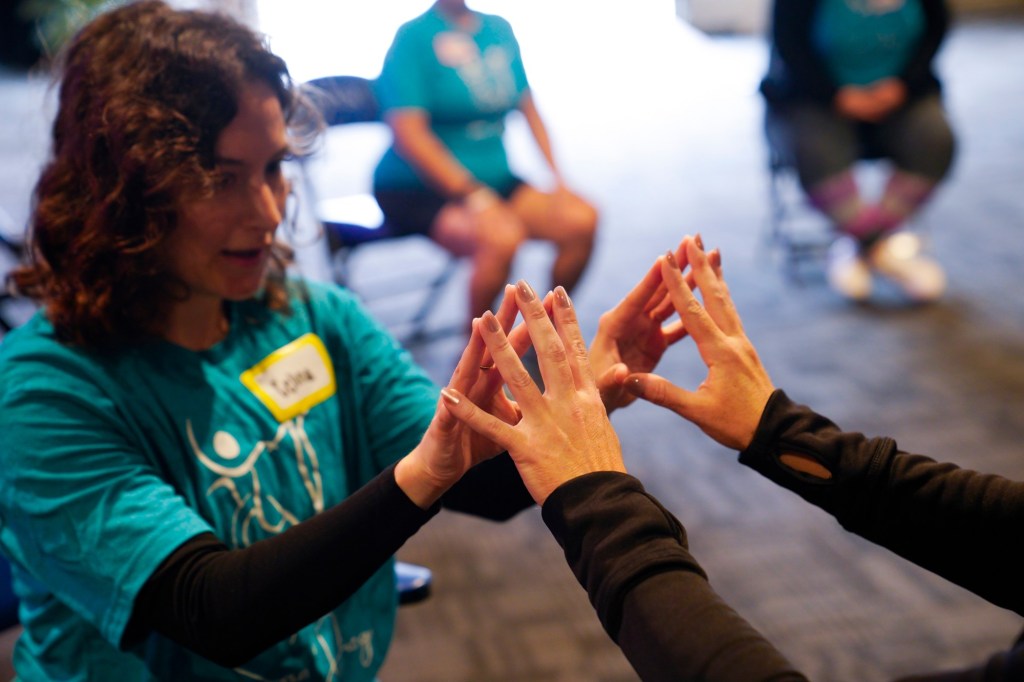A neurological disease diagnosis starts with a spark of fear and spreads like a wildfire, transforming the landscape of life.
Those afflicted with conditions such as multiple sclerosis (MS), Parkinson’s disease and Amyotrophic Lateral Sclerosis (ALS) scramble for cures or interventions to stop the progression.
Clinicians strategize.
Caregivers struggle with the stress of sharing the suffering of loved ones.
Lexii Regina Alcaraz realized that her unique understanding of that process could help bring families through the fire by creating an experience that was missing from neurorehabilitation.
Both a physical therapist and professional movement artist, Alcaraz collaborated with Malashock Dance to create San Diego NeuroDance, a pilot program that launched earlier this year.
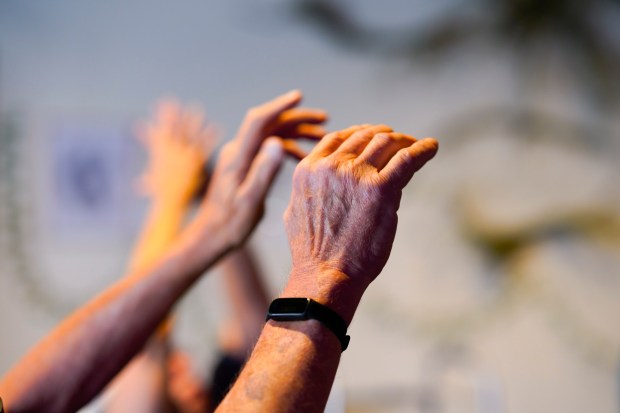 During a San Diego NeuroDance class, 72-year-old Ron Weidner works on hand and finger exercises with his wife and primary caregiver, Kitty Weidner. Weidner, a former home painting contractor, retired after later being diagnosed with Parkinson’s disease. (Nelvin C. Cepeda / The San Diego Union-Tribune)
During a San Diego NeuroDance class, 72-year-old Ron Weidner works on hand and finger exercises with his wife and primary caregiver, Kitty Weidner. Weidner, a former home painting contractor, retired after later being diagnosed with Parkinson’s disease. (Nelvin C. Cepeda / The San Diego Union-Tribune)
Simply put, the program funded by The Prebys Foundation’s Healing Through the Arts grant, brings together dance professionals, physical therapists, trained volunteers, caregivers and those suffering from a range of neurological conditions for a no-pressure hour of music and — this is the surprising part — dance.
“In the medical system, insurance dictates what you have time for and what is goal-based,” explained Alcaraz, who earned a bachelor’s degree in neuroscience from Indiana University Bloomington and a doctorate in physical therapy from San Diego State University.
“Quality of life can get put by the wayside. It’s more about how you need to transfer efficiently and safely, rather than, this is how you can hold someone up, look them in the eyes, hug them and have that human connection. I wanted to create this program to let people have a space where we would be able to precipitate what challenges they might have — a place where the participants can just focus on learning something new, having fun and connecting with their loved ones.”
The inspiration
Alcaraz was motivated to create the program after caring for her dad, who was diagnosed in 2019 with ALS, also known as Lou Gehrig’s disease.
At the time, she was living at home and enrolled in SDSU’s physical therapy doctoral program.
Alcaraz and her mom became her father’s caregivers.
“It is a devastating disease,” Alcaraz acknowledged. “But I had the support of my teachers and I knew enough to help him. And we were going to make it fun.”
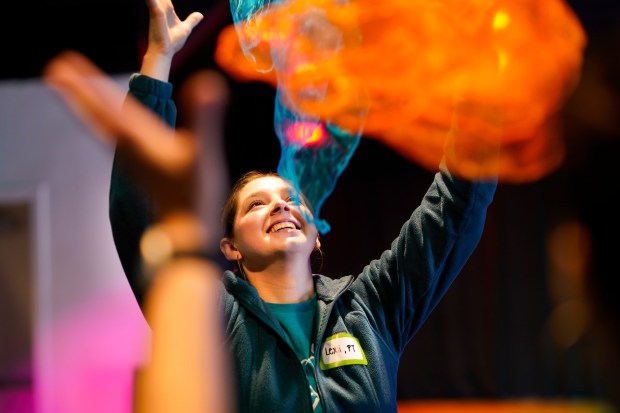 Lexii Regina Alcaraz uses a chiffon scarf as a prop during one of the dance exercises at a San Diego NeuroDance class held at The Chrysalis: Monarch Center for the Arts. (Nelvin C. Cepeda / The San Diego Union-Tribune)
Lexii Regina Alcaraz uses a chiffon scarf as a prop during one of the dance exercises at a San Diego NeuroDance class held at The Chrysalis: Monarch Center for the Arts. (Nelvin C. Cepeda / The San Diego Union-Tribune)
Alcaraz grew up in Chula Vista, and her first passion was circus arts, an art form that continues to move her. She’s the artistic director for the award-winning Lighthouse Circus Theatre, and she often trains and supports theater and dance artists.
But SD NeuroDance, she said, is “super personal” for her.
When her older sister got married in 2020, her father had difficulty standing. For the wedding reception, Alcaraz taught her sister how to support her dad, so they could have a father and daughter dance. A year later, her father died at the age of 59, and Alcaraz remembered that despite the difficult times in caregiving, there was “so much joy.”
“I think it’s because we took the time to have fun with it,” she added, “and because of my physical therapy background, I felt confident knowing how to help my dad move and feel safe.”
The preparation
Alcaraz contacted Molly Puryear, the executive director of Malashock Dance and the first dance teacher she trained with in San Diego.
Together, they collaborated on applying for The Prebys Foundation’s Healing Through the Arts initiative.
After months of planning, the Preybys Foundation awarded $64,000 to help fund the program.
It was cause for celebration, but that was just the beginning.
“There are many things that have to be lined up in order to apply for a grant, and even then, you might not get it,” said Puryear, who added that the application process takes about 40 hours to complete.
“We hired two dance teaching artists plus two physical therapists, and all of them participated in 24 hours of paid training.”
Additionally, a documentarian was hired to film the classes as a tool for advocacy. Numerous volunteers, who underwent six hours of training, were recruited. Another goal was to find a venue at an ideal location with availability on Saturdays through November.
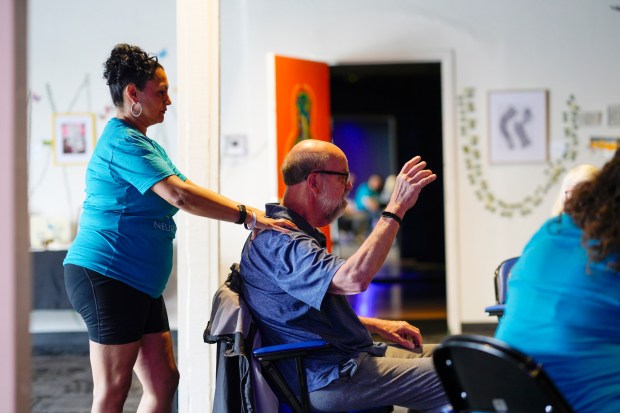 At The Chrysalis: Monarch Center for the Arts, Ron Weidner works with his physical therapist, Rosalia Arellano, on hand and foot dance movement. Weidner, a former home painting contractor, retired after later being diagnosed with Parkinson’s disease. (Nelvin C. Cepeda / The San Diego Union-Tribune)
At The Chrysalis: Monarch Center for the Arts, Ron Weidner works with his physical therapist, Rosalia Arellano, on hand and foot dance movement. Weidner, a former home painting contractor, retired after later being diagnosed with Parkinson’s disease. (Nelvin C. Cepeda / The San Diego Union-Tribune)
The Monarch Center of the Arts was chosen because it’s accessible for all mobility devices, there is convenient parking, a large clean bathroom that’s wheelchair-accessible, and there is public transportation nearby.
That was a significant consideration, Puryear said, because transportation can be a barrier to those with mobility challenges.
Many clinical studies have proven that dance movement therapy can improve motor function and cognitive deficits in neurodegenerative conditions, particularly in Parkinson’s disease.
But more studies are needed to address the myriad of conditions and symptoms.
“I think it’s important to know that for us, this is truly a pilot,” Puryear stressed. “The physical therapists and dance teaching artists are all saying this is a game changer. This is groundbreaking work.”
The delegations
After completing the SD NeuroDance training, two physical therapists (Paige Tolle and Rosalia Arellano) and two dance artists (Tina Carreras and Celina Naima Speck) were chosen to design classes that accommodated multiple neurological disorders, with a relatable soundtrack of their choosing.
Carreras is a professional dancer, choreographer and a teaching artist for San Diego Dance Theater’s Aging Creatively class.
She instructed a slower-paced class for progressive atrophying conditions, such as MS and ALS, and participants could choose to sit or stand.
The session began with everyone seated in a circle. Soothing music played while Carreras described and demonstrated ballet foot articulation.
“There are very specific extensions, like pointing the toes,” Carreras said. “It’s a nice, soft way to slow things down by stretching and warming up the feet.”
Her class included a self-hug and songs such as “Step Into Your Power” by Ray LaMontagne and Perry Como’s “Catch a Falling Star.”
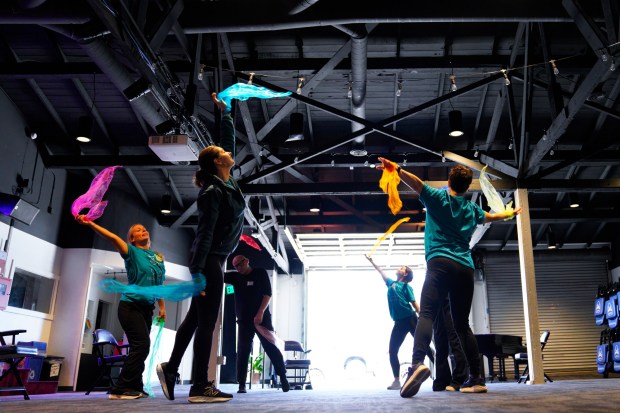 Teachers and students use scarves as a prop during a dance exercise at a San Diego NeuroDance class. (Nelvin C. Cepeda / The San Diego Union-Tribune)
Teachers and students use scarves as a prop during a dance exercise at a San Diego NeuroDance class. (Nelvin C. Cepeda / The San Diego Union-Tribune)
She also passed out floaty, chiffon scarves, “a fun, tactile prop,” in shades of red, green, white and blue.
“It’s like an extension of the arm and you can say, ‘Make a circle with your hand’ and it enhances the movement,” Carreras said. “I can take the creativity I have that is intentional, and I can guide movement in a way that’s explorative and beneficial for all these neurological conditions.”
Speck earned a bachelor of arts in contemporary dance from Zurich University of the Arts (ZHdK) in Switzerland, and she’ll perform in San Diego Dance Theater’s upcoming Trolley Dances.
Speck also has a teaching certificate from Dancing Wheels, an Ohio-based company that utilizes the talents of dancers both with and without disabilities.
She began a recent session by asking her participants to name something they feel grateful for, an exercise that “changes the energy in the room.”
Her soundtrack included artists such as Elton John, ABBA and Frank Sinatra’s version of “When You’re Smiling (The Whole World Smiles With You).”
“That song is especially helpful for those afflicted with Parkinson’s because for some, their facial expressions are getting smaller as their disease progresses,” Speck said. “I’m aiming for the biggest facial expressions we can get.”
Kitty and Ron Weidner, both in their early 70s, attended Speck’s class this month. Ron has symptoms of Parkinson’s disease and Kitty is his primary caregiver.
They attended Speck’s class at Arellano’s suggestion because Arellano, who earned a doctorate in physical therapy in addition to being a board certified neurologic clinical specialist, is Ron’s physical therapist.
The couple accomplished something that surprised them both. They danced to “Night Fever” by the Bee Gees.
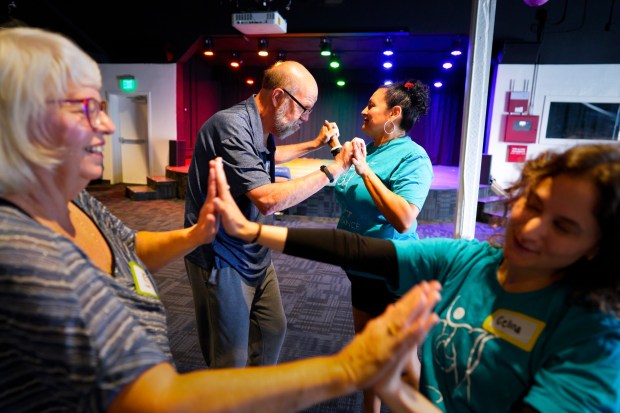 At The Chrysalis: Monarch Center for the Arts, Ron Weidner goes through hand and foot exercises with his physical therapist, Rosalia Arellano. (Nelvin C. Cepeda / The San Diego Union-Tribune)
At The Chrysalis: Monarch Center for the Arts, Ron Weidner goes through hand and foot exercises with his physical therapist, Rosalia Arellano. (Nelvin C. Cepeda / The San Diego Union-Tribune)
The ramifications
“We had a good time,” Kitty Weidner said by phone after the class.
“Ron needs a lot of direction, and most of the time, I lead. But he did well, and it helped him immensely. We are doing what we need to do to keep him mentally and physically active. I thought it was very worthwhile, and I enjoyed it, too. Over the years, we have danced together. We had a rock ‘n’ roll band at our wedding reception. We’ve been married for 44 years.”
Arellano said that recruiting for SD NeuroDance requires trust. She explained that people with these diagnoses are trying to physically improve, but when they hear about a dance class, they are likely to say, “A dance class for fun? You’re joking, right?” An environment that is judgement- and goal-free, however, allows participants to share a different experience.
“I’ve been in rehabilitation for a long time and our focus as physical therapists is on function and independence — things we need in the community for our survival,” Arellano said.
“But we don’t see classes like this. It was really fun to watch Ron and Kitty do some of the dance moves from their youth. The focus for SD NeuroDance is not rehab and survival. Rather, it’s thriving and being human and connecting our common denominators. It’s music and love.”
Anyone can join a SD NeuroDance session. For more information visit malashockdance.org/neurodance.
